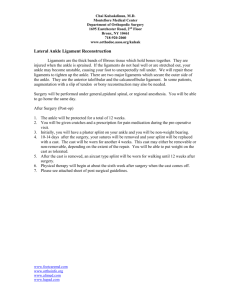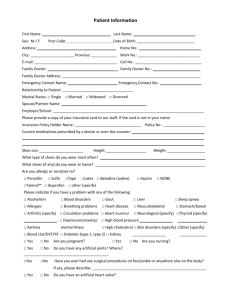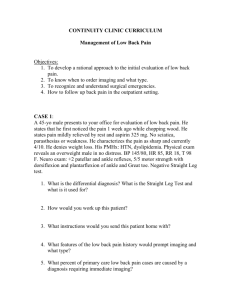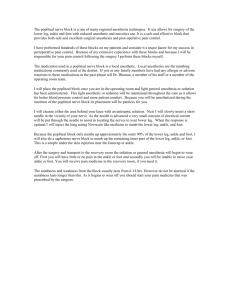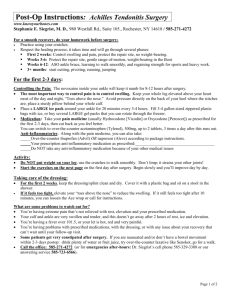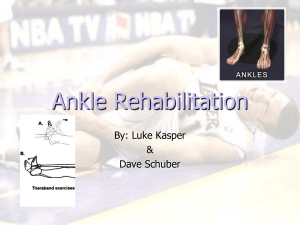A Patient's Guide To Lateral Ligament Reconstruction Of The Ankle
advertisement
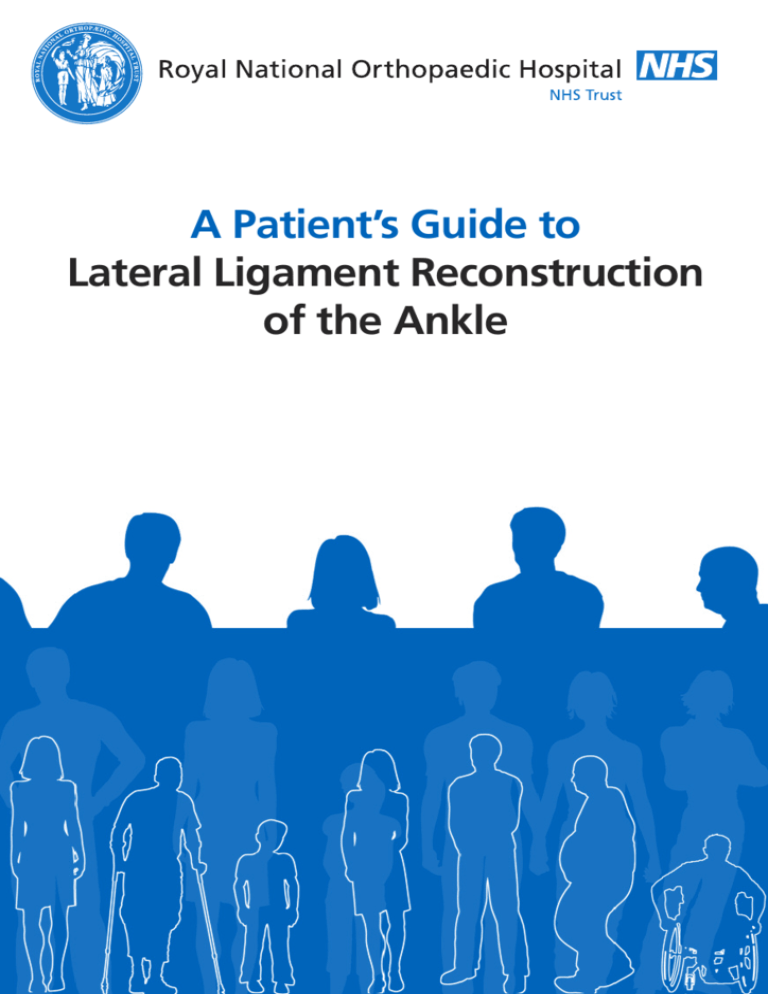
A Patient’s Guide to Lateral Ligament Reconstruction of the Ankle The Foot and Ankle unit at the Royal National Orthopaedic Hospital (RNOH) is a multi-disciplinary team. The team consists of three specialist orthopaedic foot and ankle consultant surgeons (Mr Singh, Mr Cullen and Mr Goldberg), specialist doctors in training, a physician assistant, a clinical nurse specialist, orthotists, physiotherapists and occupational therapists. All team members specialise in foot and ankle care and work together to provide and deliver a quality service. The ankle joint The ankle is a hinge joint between the leg and the foot, and allows up/down and side/side movement. Stability is provided by strong ligaments either side of the ankle. The ligament on the outside of the ankle is called the lateral ligament. It is made up of three bands connecting the fibula (the prominent bone on the outside of the ankle) and the talus (ankle bone) and calcaneus (heel bone). If the ankle is twisted, the ligaments can become stretched or torn. This is known as a sprained ankle. 2 Fibula Tibia Calcaneo fibular ligament Anterior talofibular ligament Calcaneus Talus Reasons for lateral ligament repair Most ankle sprains heal by themselves. In a small number of patients, the ligaments don’t heal or heal in a lengthened position so are no longer tight. Because these lax, ankle ligaments can no longer hold the ankle in place, the ankle tends to give way and becomes unstable. The ankle gives way, especially on uneven ground or when changing direction quickly. In most cases, this can be improved with physiotherapy. If not, ligament repair may be required. 3 Surgical techniques We carry out two types of ankle ligament repair: • Brostrom-Gould: This operation is usually performed under a general anaesthetic. An incision (cut) is made over the outside of the ankle. The stretched ligament is cut and then overlapped and sewn together again under tension. A thick band of tissue called the extensor retinaculum is sewn over the top, further re-enforcing it. The skin is then carefully sewn up and a plaster of paris cast is applied from below the knee to the ball of the foot. You will remain in plaster for four weeks and in an ankle brace for up to eight weeks after this. • Tendon reconstruction: This operation is usually done under a general anaesthetic. An incision is made over the outside of the ankle. There are two tendons called the ‘peroneal tendons’ that run along the outside of the ankle. A small portion (usually 1/3 ) of one of these tendons is used as a tendon graft. It is taken from the tendon along its length and passed through small drill holes in the ankle bone (fibula), tightened and fixed to the heel bone (calcaneus), which will reform the ankle ligaments. The skin is carefully sewn up and a plaster of paris cast is applied from below the knee to the ball of the foot. You will remain in plaster for four weeks and in an ankle brace for up to eight weeks after this. 4 Expected outcome: • Improved function/mobility • Improved pain relief, and less need to take painkillers • Improved ankle stability • Less need for orthotics/ankle braces • Return to full sporting activity • Full recovery may take up to twelve months 5 Before the operation (pre-operatively) You will see a pre-admission nurse to check you are medically well enough for surgery. It is important to mention any medicines that you are taking, either prescribed or non-prescribed, including over the counter medications, herbal remedies or aspirin, warfarin, hormone replacement therapy (HRT), the contraceptive pill or medication for high blood pressure. Before admission for your surgery, there are a number of issues that need to be considered, for example, can someone help you carry out basic everyday tasks such as preparing and shopping for food? If you have stairs, how will you get up and down them? Do you have sturdy hand rails? If your toilet is downstairs, would it be easier to have your bed downstairs until you have recovered and are able to negotiate the stairs safely? The pre-admission nurse will discuss these with you and if they have any concerns about coping at home after your operation, they may refer you to a physiotherapist and/or an occupational therapist. The therapist will telephone you to discuss your needs and it may be necessary to attend a more in-depth assessment. This will ensure that we plan for your discharge home safely and shorten your stay in hospital. What to bring with you Please ensure that you have a flat sturdy shoe to wear on the unoperated foot following surgery. If you use a walking stick or crutches, please ensure you bring these with you too. 6 What to expect after the operation When you arrive back on the ward from theatre, your leg will be in a plaster cast back slab (half plaster) from toe to knee. You need to make sure that you do not get the plaster wet. You will also have stitches or staples with a dressing covering the wounds. It is important to keep your leg elevated to above groin level for 55 minutes in every hour for the first two weeks following the operation. This helps to reduce swelling. It is then important that you continue to elevate your leg regularly over the next few weeks/months. A physiotherapist will see you on the ward and show you how to walk using a walking aid. You are normally allowed to put weight through your operated ankle while it is in the plaster cast. If you have to use stairs at home, you will be taught the safest way to do this. Depending on your surgery, there may be some restrictions, but these will be explained to you in detail. You will usually remain in hospital for approximately one to two days after your operation. 7 Outpatient review After two weeks, you will have your plaster changed and stitches removed. If the team in clinic are happy that everything is progressing as it should, you may be allowed to start putting weight through your leg. You will normally have the plaster removed six weeks after the operation and at this time you will usually be given a brace to wear on the ankle. You will be referred for physiotherapy four weeks following your surgery, in order to reduce swelling, encourage movement, and regain strength, balance, function and stability. Physiotherapy is an essential part of your treatment. Without this, you have a higher risk of re-spraining your ankle. You can choose to have your physiotherapy at the RNOH or your local hospital. Getting back to normal: • Returning to work: If your job is mostly sitting, you may be allowed back to work after four weeks, provided you can keep the leg elevated. However, if your job is more physical and involves long periods on your feet, then it may take longer. • Walking: You should be out of the boot/plaster cast and walking normally by six weeks. However, this will depend on whether the surgeon has placed any specific restrictions on you and it may take longer. 8 • Driving: If you have an automatic car and undergone surgery on the left ankle, you can usually drive by two weeks after your operation. Otherwise, it may take about two months to be able to drive. In order to be safe to drive, you must be able to perform an emergency stop. Also, you must inform your insurance company about the type of operation that you have undergone to ensure that your cover is valid. • Sport: Resuming sporting activity depends on your operation and how quickly your strength, movement and balance recover. Generally you can return to low impact sports between three and six months after your operation, but returning to high impact sports can take up to a year. 9 Things to look out for: • Swelling – you should expect some swelling after your operation. If swelling persists or worsens and you are concerned, seek advice from a member of the foot and ankle team or your GP. • Infection – any operation is at risk of infection. Fortunately it is not common in this type of surgery but a small number of patients do get a wound infection and these normally settle after a short course of antibiotics. In rare circumstances the infection may be more severe and require further surgery to remove infected tissue and administer a longer course of antibiotics. • Blood clots – Deep Vein Thrombosis (DVT) or Pulmonary Embolus (PE) are rare but can occur. Please inform the team if you have had a DVT or PE in the past or if you have a family history of clotting disorders. You will be given an anti-embolic stocking to wear on your other leg and blood thinning injections while your leg is in plaster. • Numbness or tingling – this can occur at the surgical site(s) if fine, hair-like nerves are cut or more major nerves are stretched. This is normally temporary, however, patchy numbness or sensitised areas may be permanent. In rare circumstances the nerves can become hypersensitive, in a condition called Complex Regional Pain Syndrome. This can lead to severe pain as well as colour and temperature changes in the foot. If this happens, your consultant will discuss treatment with you. 10 • Wound healing – if blood supply to the area is not good, wounds may be slow to heal. If this is the case, more frequent wound dressings may be required to ensure that the wound does not become infected. • Scarring – any type of surgery will leave a scar. Occasionally this can cause pain and irritation. If this happens, please speak with your consultant. REPORT SEVERE PAIN, MASSIVE SWELLING, CHEST PAIN, EXCESSIVE NUMBNESS OR PINS AND NEEDLES TO YOUR GP OR THE FOOT AND ANKLE TEAM AS SOON AS POSSIBLE. 11 If you have any comments about this leaflet or would like it translated into another language/large print, please contact the Clinical Governance Department on 020 8909 5439/5717. Royal National Orthopaedic Hospital NHS Trust Brockley Hill Stanmore Middlesex HA7 4LP Email: foot.ankle@rnoh.nhs.uk Telephone: 020 8909 5125 www.rnoh.nhs.uk 11-19 © RNOH Publication date: September 2011 Date of last review: August 2011 Date of next review: August 2013 Author: Karen Alligan


